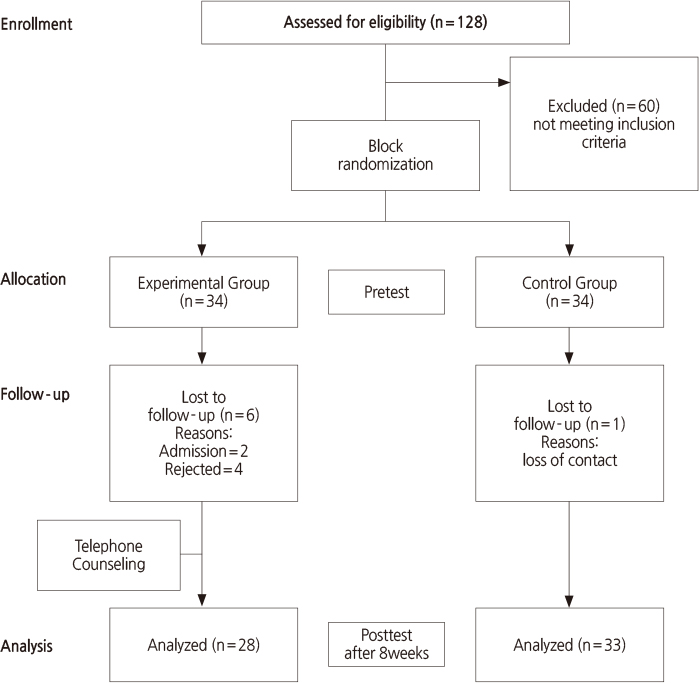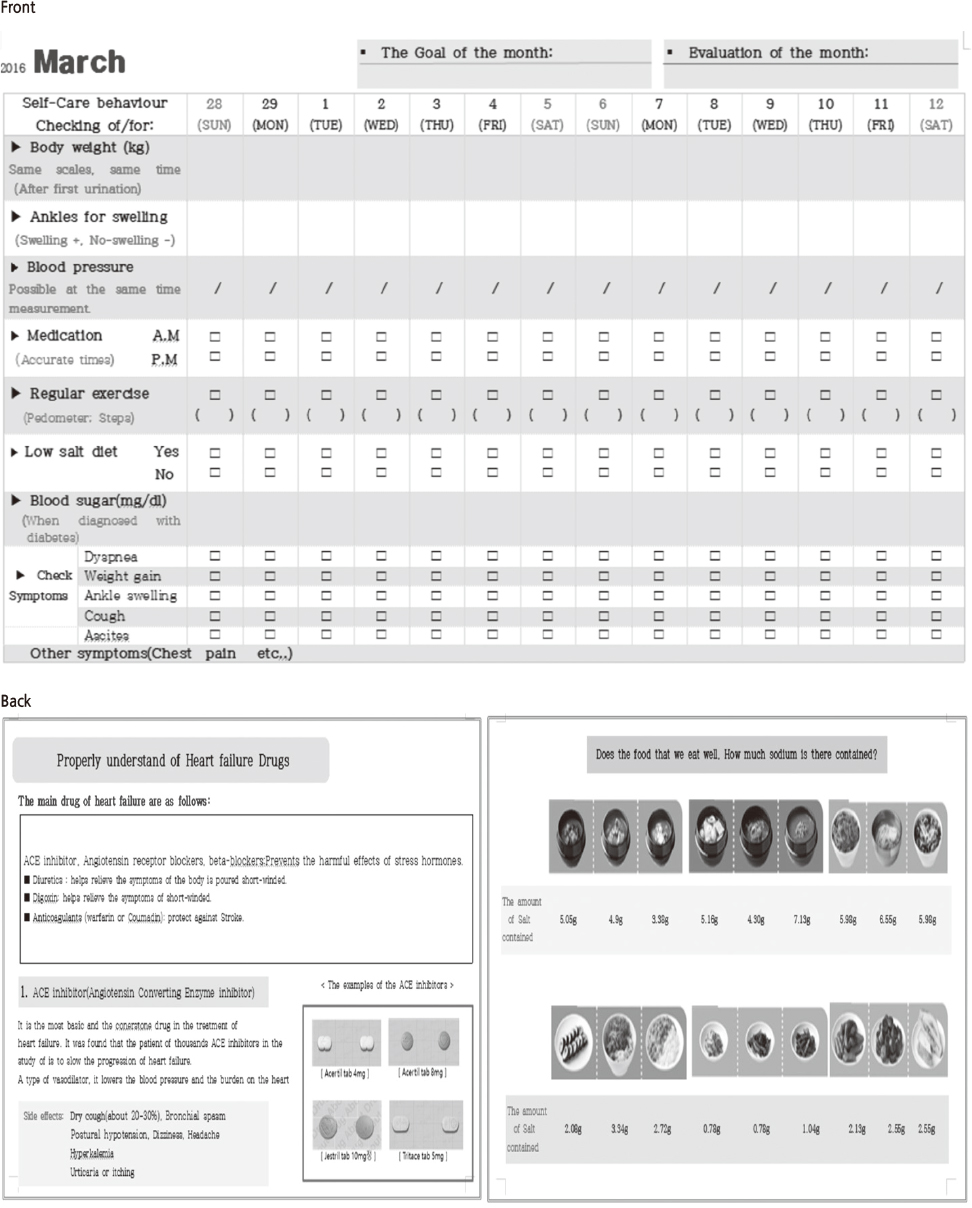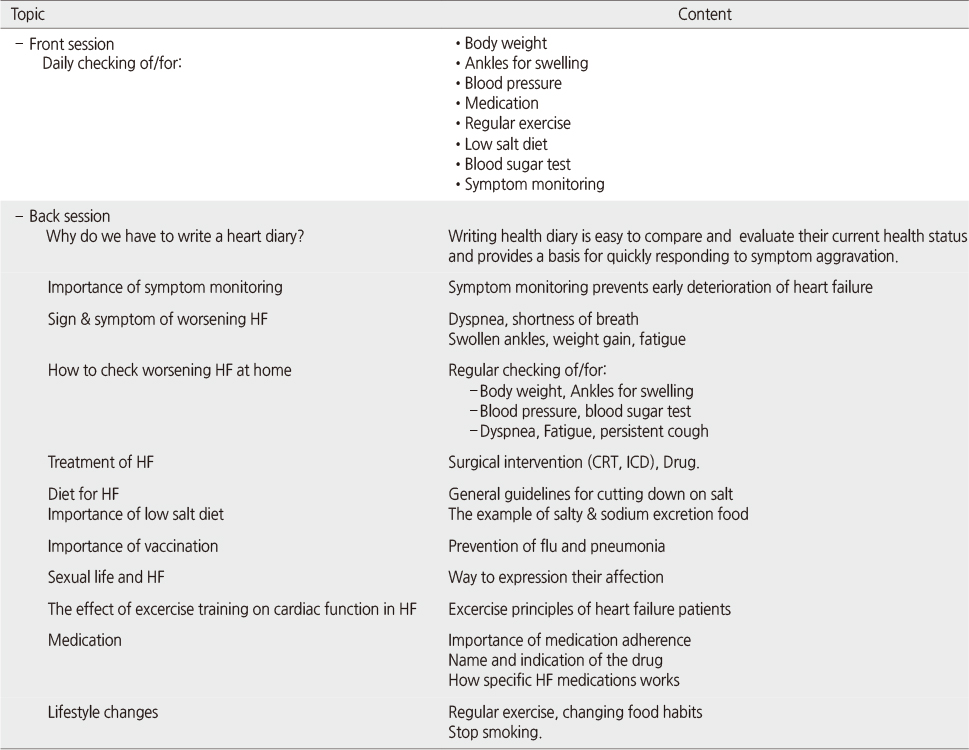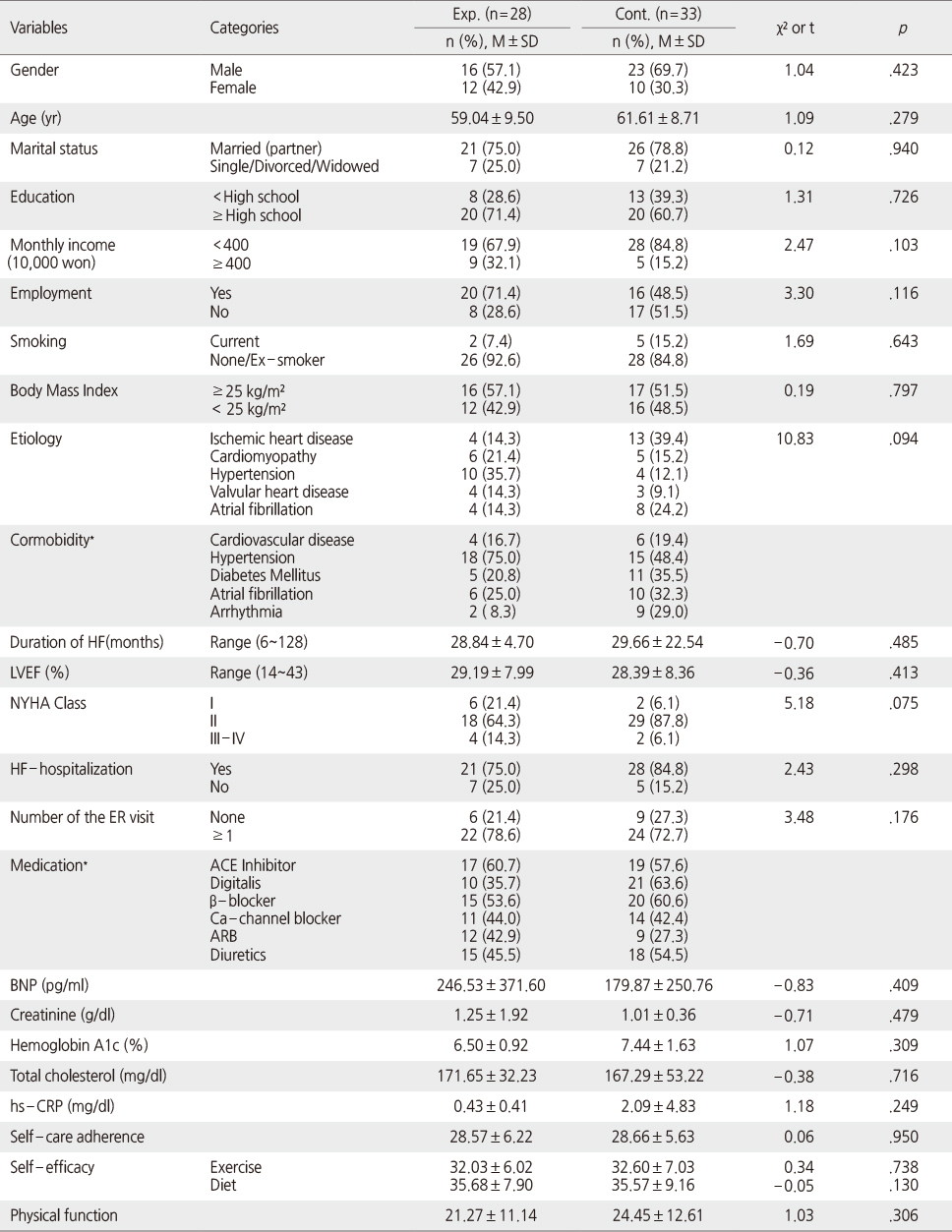Articles
- Page Path
- HOME > J Korean Acad Nurs > Volume 46(6); 2016 > Article
-
Original Article
- Development and Effects of a Heart Health Diary for Self-Care Enhancement of Patients with Heart Failure
- Jae Lan Shim, Seon Young Hwang
-
Journal of Korean Academy of Nursing 2016;46(6):881-893.
DOI: https://doi.org/10.4040/jkan.2016.46.6.881
Published online: December 30, 2016
School of Nursing, Hanyang University, Seoul, Korea.
- Address reprint requests to : Hwang, Seon Young. College of Nursing, Hanyang University, 222 Wangsimri-ro, Seongdong-gu, Seoul 04763, Korea. Tel: +82-2-2220-0702, Fax: +82-2-2220-1163, seon9772@hanyang.ac.kr
© 2016 Korean Society of Nursing Science
This is an Open Access article distributed under the terms of the Creative Commons Attribution NoDerivs License. (http://creativecommons.org/licenses/by-nd/4.0/) If the original work is properly cited and retained without any modification or reproduction, it can be used and re-distributed in any format and medium.
Abstract
-
Purpose
- The purpose of this study was to develop a heart health diary to promote self-care ability among patients with heart failure (HF), and to identify the diary's effect on self-care adherence, self-efficacy, and physical activity.
-
Methods
- A randomized control-group pretest-posttest design was adopted using block randomization. A calender-typed health diary was developed and it included a self-care checklist and education information on HF management. The experimental group were given guided counseling and education for 8 weeks and wrote a daily health diary during that period. Data were collected from the outpatient department of a tertiary medical center from February to April 2016. To verify the hypotheses, data for the experimental group (n=28) and control group (n=33) were analysed using the independent t-test with SPSS/WIN 21.0.
-
Results
- At the end of 8 weeks the experimental group had significantly higher scores for self-care adherence (t=-2.48, p =.016) and exercise related self-efficacy (t=-3.44, p =.001) compared to the control group.
-
Conclusion
- The findings show that the application of a patient-directed heart health diary is an effective nursing intervention for improving HF patients' self-care adherence and exercise self-efficacy. Strategies to promote dietary self-efficacy are necessary along with further studies including repeated research with an increasing intervention period. Healthcare providers need to encourage the utilization of a health diary for HF patients as a tool for evaluation and for implementation that leads to self-care.
*This manuscript is based on a part of the first author's doctoral dissertation from Hanyang University.
*This study was supported by the National Research Foundation of Korea funded by the Ministry of Education (NRF# 2015R1D1A1A01060938).
- 1. Ambrosy AP, Fonarow GC, Butler J, Chioncel O, Greene SJ, Vaduganathan M, et al. The global health and economic burden of hospitalizations for heart failure: Lessons learned from hospitalized heart failure registries. J Am Coll Cardiol. 2014;63(12):1123–1133. PubMed
- 2. Health Insurance Review & Assessment Service. Disease statistics [Internet]. Wonju, Author. 2016;cited 2016 March 2. Available from:https://www.hira.or.kr/rd/dissdic/infoSickList.do?pgmid= HIRAA020044020100
- 3. Dharmarajan K, Hsieh AF, Lin Z, Bueno H, Ross JS, Horwitz LI, et al. Diagnoses and timing of 30-day readmissions after hospitalization for heart failure, acute myocardial infarction, or pneumonia. JAMA. 2013;309(4):355–363. ArticlePubMedPMC
- 4. Farmakis D, Parissis J, Lekakis J, Filippatos G. Acute heart failure: Epidemiology, risk factors, and prevention. Rev Esp Cardiol (Engl Ed). 2015;68(3):245–248. ArticlePubMed
- 5. Delaney C, Bartos S, Morrison H, Smith L, Fortinsky R. A randomized trial of telemonitoring and self-care education in heart failure patients following home care discharge. Home Health Care Manag Pract. 2013;25(5):187–195. ArticlePDF
- 6. Ponikowski P, Voors AA, Anker SD, Bueno H, Cleland JG, Coats AJ, et al. 2016 ESC Guidelines for the diagnosis and treatment of acute and chronic heart failure: The Task Force for the diagnosis and treatment of acute and chronic heart failure of the European Society of Cardiology (ESC)Developed with the special contribution of the Heart Failure Association (HFA) of the ESC. Eur Heart J. 2016;37(27):2129–2200. ArticlePubMed
- 7. Dracup K, Moser DK, Pelter MM, Nesbitt TS, Southard J, Paul SM, et al. Randomized, controlled trial to improve self-care in patients with heart failure living in rural areas. Circulation. 2014;130(3):256–264. ArticlePubMed
- 8. Lee ES, Shin ES, Hwang SY, Chae MJ, Jeong MH. Effects of tailored supportive education on physical, emotional status and quality of life in patients with congestive heart failure. Korean J Adult Nurs. 2013;25(1):62–73. ArticlePDF
- 9. Lee KS, Lennie TA, Warden S, Jacobs-Lawson JM, Moser DK. A comprehensive symptom diary intervention to improve outcomes in patients with HF: a pilot study. J Card Fail. 2013;19(9):647–654. ArticlePubMed
- 10. White MM, Howie-Esquivel J, Caldwell MA. Improving heart failure symptom recognition: a diary analysis. J Cardiovasc Nurs. 2010;25(1):7–12. PubMed
- 11. Wright SP, Walsh H, Ingley KM, Muncaster SA, Gamble GD, Pearl A, et al. Uptake of self-management strategies in a heart failure management programme. Eur J Heart Fail. 2003;5(3):371–380. ArticlePubMed
- 12. Jones CD, Holmes GM, Dewalt DA, Erman B, Broucksou K, Hawk V, et al. Is adherence to weight monitoring or weight-based diuretic self-adjustment associated with fewer heart failure-related emergency department visits or hospitalizations? J Card Fail. 2012;18(7):576–584. ArticlePubMedPMC
- 13. Fisher JD, Fisher WA. Changing AIDS-risk behavior. Psychol Bull. 1992;111(3):455–474. ArticlePubMed
- 14. The Korean Society of Heart Failure. KSHF guideline for the management of Chronic heart failure 2016. Seoul: Author; 2016. p. 1–132.
- 15. Mohammadi E, Khoshab H, Kazemnejad A. Activities of daily living for patients with chronic heart failure: A partnership care model evaluation. Appl Nurs Res. 2016;30:261–267. ArticlePubMed
- 16. Jaarsma T, Strömberg A, Mårtensson J, Dracup K. Development and testing of the European heart failure self-care behaviour scale. Eur J Heart Fail. 2003;5(3):363–370. ArticlePubMed
- 17. Hickey ML, Owen SV, Froman RD. Instrument development: cardiac diet and exercise self-efficacy. Nurs Res. 1992;41(6):347–351. PubMed
- 18. Sung J, On YK, Kim HS, Chae IH, Sohn DW, Oh BH, et al. Development of Korean activity scale/index (KASI). Korean Circ J. 2000;30(8):1004–1009. Article
- 19. Aroian KJ, Vander Wal JS. Measuring elders’ symptoms with daily diaries and retrospective reports. West J Nurs Res. 2007;29(3):322–337. ArticlePubMedPDF
- 20. Garber MC, Nau DP, Erickson SR, Aikens JE, Lawrence JB. The concordance of self-report with other measures of medication adherence: A summary of the literature. Med Care. 2004;42(7):649–652. PubMed
- 21. Vuorinen AL, Leppänen J, Kaijanranta H, Kulju M, Heliö T, van Gils M, et al. Use of home telemonitoring to support multidisciplinarycare of heart failure patients in Finland: Randomized controlled trial. J Med Internet Res. 2014;16(12):e282ArticlePubMedPMC
- 22. Kato N, Kinugawa K, Ito N, Yao A, Watanabe M, Imai Y, et al. Adherence to self-care behavior and factors related to this behavior among patients with heart failure in Japan. Heart Lung. 2009;38(5):398–409. ArticlePubMed
- 23. Wolf A, Fors A, Ulin K, Thorn J, Swedberg K, Ekman I. An ehealth diary and symptom-tracking tool combined with person-centered care for improving self-efficacy after a diagnosis of acute coronary syndrome: A substudy of a randomized controlled trial. J Med Internet Res. 2016;18(2):e40ArticlePubMedPMC
- 24. Brooman S, Darwent S. A positive view of first-year undergraduate reflective diaries: Focusing on what students can do. Reflect Prac. 2012;13(4):517–531. Article
- 25. Messier SP, Mihalko SL, Legault C, Miller GD, Nicklas BJ, De Vita P, et al. Effects of intensive diet and exercise on knee joint loads, inflammation, and clinical outcomes among overweight and obese adults with knee osteoarthritis: the IDEA randomized clinical trial. JAMA. 2013;310(12):1263–1273. PubMedPMC
- 26. Bos C, Van der Lans IA, Van Rijnsoever FJ, Van Trijp HC. Understanding consumer acceptance of intervention strategies for healthy food choices: A qualitative study. BMC Public Health. 2013;13:1073ArticlePubMedPMCPDF
- 27. Riegel B, Driscoll A, Suwanno J, Moser DK, Lennie TA, Chung ML, et al. Heart failure self-care in developed and developing countries. J Card Fail. 2009;15(6):508–516. ArticlePubMedPMC
- 28. Shin ES, Hwang SY, Jeong MH, Lee ES. Relationships of factors affecting self-care compliance in acute coronary syndrome patients following percutaneous coronary intervention. Asian Nurs Res (Korean Soc Nurs Sci). 2013;7(4):205–211. ArticlePubMed
- 29. Devi R, Powell J, Singh S. A web-based program improves physical activity outcomes in a primary care angina population: Randomized controlled trial. J Med Internet Res. 2014;16(9):e186ArticlePubMedPMC
- 30. Feltner C, Jones CD, Cené CW, Zheng ZJ, Sueta CA, Coker-Schwimmer EJ, et al. Transitional care interventions to prevent readmissions for persons with heart failure: A systematic review and meta-analysis. Ann Intern Med. 2014;160(11):774–784. ArticlePubMed
REFERENCES
Figure & Data
REFERENCES
Citations

- Integrating Generative AI into Clinical Practice Education: Enhancing Personalized Medicine Delivery Skills for Korean Medicine Students
Miso S. Park, Ju Hyun Jeon, Junyoung Hur, Horyong Yoo, Ji-Yeon Lee
Journal of Korean Medicine.2025; 46(1): 87. CrossRef - Development of Core Educational Content for Heart Failure Patients in Transition from Hospital to Home Care: A Delphi Study
Seo-Jin Lee, Bo-Hwan Kim
International Journal of Environmental Research and Public Health.2022; 19(11): 6550. CrossRef - Development of a discharge education program using the teach-back method for heart failure patients
Eui Geum Oh, Hyun Joo Lee, You Lee Yang, Sewon Lee, Young Man Kim
BMC Nursing.2021;[Epub] CrossRef - Effects of a smartphone-based self-care health diary for heart transplant recipients: A mixed methods study
Hye Jin Yoo, Eunyoung E. Suh
Applied Nursing Research.2021; 58: 151408. CrossRef - Validity and Reliability of Revised Version of the Self-Care Behaviors Scale-Korean (SCBS-K19) for Rheumatoid Arthritis Patients
Geungyeong Park, Heeyoung Oh
Korean Journal of Adult Nursing.2021; 33(3): 294. CrossRef - Development of a Mobile App-Based Self-care Health Diary for Heart Transplant Recipients
Hye Jin Yoo, Eunyoung E. Suh
CIN: Computers, Informatics, Nursing.2021; 39(11): 804. CrossRef - Association Between Symptoms of Patients With Heart Failure and Patient Outcomes Based on Electronic Nursing Records
Seung Yeon Baik, Gi Wook Ryu, Hyangkyu Lee, Siwook Lee, Mona Choi
CIN: Computers, Informatics, Nursing.2021; 39(12): 1027. CrossRef - Using Online Self-Management Diaries for Qualitative Research
Seyedehtanaz Saeidzadeh, Stephanie Gilbertson-White, Kristine L. Kwekkeboom, Faezeh Babaieasl, Aaron T. Seaman
International Journal of Qualitative Methods.2021;[Epub] CrossRef - The mediating effect of resilience on the relationship between Type D personality and self‐care behavior in patients with heart failure
Ji Min Heo, Chul‐Gyu Kim
Japan Journal of Nursing Science.2020;[Epub] CrossRef


Figure 1
Figure 2
Contents of Heart Health Diary
HF=heart failure; CRT=cardiac resynchronisation therapy; ICD=implantable cardioverter-defibrillator.
Homogeneity Test of Characteristics and Dependent Variables of Subjects
Exp.=Experimental group; Cont.=Control group; LVEF= Left ventricular ejection fraction; ACE: Angiotensin converting enzyme; ARB: Angiotensin receptor blocker; NYHA=New york heart association; BNP=Brain natriuretic peptide; hs-CRP;High-sensitivity C-reactive protein *Multiple response.
Differences in the Dependent Variables between Experimental and Control Groups
Exp.=Experimental group; Cont.=Control group; M=Mean; SD=Standard deviation.
HF=heart failure; CRT=cardiac resynchronisation therapy; ICD=implantable cardioverter-defibrillator.
Exp.=Experimental group; Cont.=Control group; LVEF= Left ventricular ejection fraction; ACE: Angiotensin converting enzyme; ARB: Angiotensin receptor blocker; NYHA=New york heart association; BNP=Brain natriuretic peptide; hs-CRP;High-sensitivity C-reactive protein *Multiple response.
Exp.=Experimental group; Cont.=Control group; M=Mean; SD=Standard deviation.
 KSNS
KSNS
 E-SUBMISSION
E-SUBMISSION





 Cite
Cite

